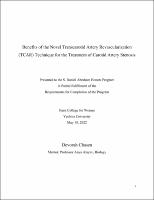Please use this identifier to cite or link to this item:
https://hdl.handle.net/20.500.12202/8268| Title: | Benefits of the Novel Transcarotid Artery Revascularization (TCAR) Technique for the Treatment of Carotid Artery Stenosis |
| Authors: | Alayev, Anna Chasen, Devorah |
| Keywords: | Cerebrovascular diseases cerebral hypoxia Carotid Artery Stenosis Carotid Endarterectomy (CEA) Transcarotid Arterial Revascularization (TCAR) cerebrovascular accident (CVA) stroke |
| Issue Date: | 18-May-2022 |
| Publisher: | Yeshiva University |
| Series/Report no.: | S. Daniel Abraham Honors Student Theses;May 18, 2022 |
| Abstract: | Cerebrovascular diseases consist of a group of cerebral blood vessel disorders which affect blood flow to the brain. Consequences of cerebrovascular disease include cell death and stroke due to cerebral hypoxia. Unfortunately, stroke is the fifth leading cause of death in the United States and the number one leading cause of disability. Carotid Artery Stenosis is one of the most common cerebrovascular disease that often leads to ischemic stroke. Carotid Artery Stenosis is typically caused by the buildup of atherosclerotic plaque, which consists of fatty substances, cholesterol, cellular waste products, calcium, and fibrin along the inner lining of the carotid artery. As the plaque grows, it protrudes into the lumen of the artery causing stenosis; subsequently, the plaque may rupture and promote the formation of a blood clot that further occludes the artery. Medical management may be effective at controlling the effects of Carotid Artery Stenosis and preventing future strokes; in certain cases of severe stenosis, however, surgical intervention is often recommended. The Carotid Endarterectomy (CEA) has been the standard surgical intervention for revascularization for almost seventy years. Until recently, no other intervention compared to it in its effectiveness and safety. However, the Transcarotid Arterial Revascularization (TCAR) technique was introduced in 2015, and studies over the past seven years have shown promising results for this novel procedure. It combines the methods of traditional stenting with a blood flow reversal neuroprotection system to create a quick, efficient, and minimally invasive revascularization option. Future studies hope to further prove its effectiveness as it becomes a more mainstream procedure to treat Carotid Artery Stenosis. |
| Description: | Undergraduate honors thesis / Open Access |
| URI: | https://hdl.handle.net/20.500.12202/8268 |
| Appears in Collections: | S. Daniel Abraham Honors Student Theses |
Files in This Item:
| File | Description | Size | Format | |
|---|---|---|---|---|
| Devorah Chasen OA Transcarotid Arterial Revascularization (TCAR) 18May2022.pdf | 502.37 kB | Adobe PDF |  View/Open |
This item is licensed under a Creative Commons License

